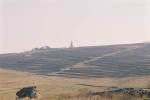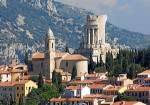…or, anybody can take a guided tour.
Travelling in western Europe, I was able to see many vestiges of the Roman Empire; Rome itself, Trier in Germany (ancient Augusta Treverorum. Underneath modern Paris is ancient Lutetia. The Raetian Limes (and the fort at Saalburg) and Castra Regina, now Regensburg, are all well known.
But with the liberation of eastern Europe, there are many sites to be explored. Some countries in eastern Europe are re-emphasizing their Latin (and in some cases their Celtic) heritage. And many other sites are located in small towns away from the large cities. Generally accessible via railroads, you can enjoy them at your own pace without tour guides. You also have the opportunity to meet the locals in a friendly environment.
Trajan’s Trophy is located in Adamclissi, Romania and was erected in 107/108 AD to celebrate the emperor’s conquest of what was then Dacia. The monument was reconstructed but the remains of the original and the ruins of Civitas Tropaeum are located nearby. Artifacts from this Roman site and from the original monument are housed in a nearby museum.
Trajan’s Bridge was situated East of the Iron Gates, near the present-day cities of Drobeta-Turnu Severin in Romania and Kladovo in Serbia. Its construction was ordered by the Emperor Trajan as a supply route for the Roman legions fighting in Dacia.
The structure was 1,135 m (3,724 ft) long (the Danube is now 800 m (2,600 ft) wide in that area), 15 m (49 ft) wide, and 19 m (62 ft) high, measured from the surface of the river. At each end was a Roman castrum, each built around an entrance, so that crossing the bridge was possible only by walking through the camps.
The bridge’s engineer, Apollodorus of Damascus, used wooden arches, each spanning 38 m (125 ft), set on twenty masonry pillars made of bricks, mortar, and pozzolana cement. It was built unusually quickly (between 103 and 105), employing the construction of a wooden caisson for each pier.
Ihtiman, Bulgaria is the site of Succi Pass, an east-west gate way through the Rhodope Mountains (Bulgarian-Despoto Planina). Located there is Trajan’s Gate, a fortress built to guard the pass and the ancient Via Militaris, the road that ran from Constantinople (modern Istanbul) to Sigidunum (modern Belgrade). There is another fort at nearby Plovdiv (ancient Philippopolis).
The ancient Via Flaminia runs from Rome to Rimini (ancient Ariminium) and passes through a tunnel excavated near modern Furlo on the orders of the Emperor Vespasian to expedite crossing the gorge of the river Candigliano. It is located in what is now the Riserva Naturale Statale della Gola del Furlo in Central Italy.
Le Perthus in south east France is located at the junction of the ancient Via Domitia and the Via Augusta and linked Italy (Italia) with Spain (Hispania). In celebrating his victory over Spanish tribes in the 70s BC, Pompey Magnus (Pompey the Great) built a trophy at this point. Le Perthus is immediatelty joined by the Spanish town of Els Limits in Catalonia.
Further north, in La Turibe, a French town in the Maritime Alps, the Emperor Augustus built a trophy to celebrate his conquest of the various tribes of the Alps. It was built along the Via Julia Augusta around 6 BC and is inscribed with the names of the 45 tribes brought into the Roman Empire.
The tragic figure of Drusus, destined to be Augustus successor and who fought so long in Germany is commemorated by his cenotaph in Mainz Germany (ancient Mogantiacum). Destined to lead the campaign to include Germania Magna (Germany beyond the Rhine) in the Empire, Drusus died in 9 BC and his troops built the memorial cenotaph.







